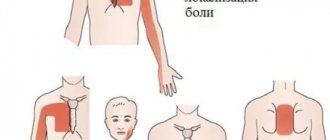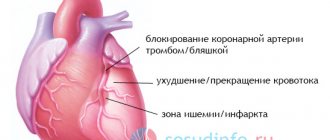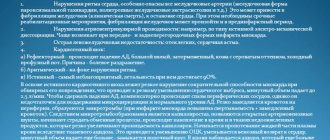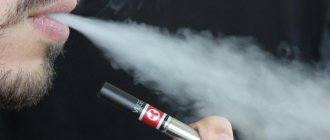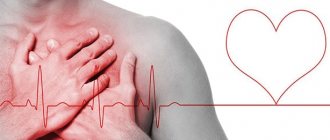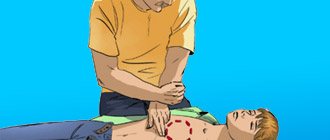Author: KarabasBarabas
23 July 2020 15:51
Tags: myocardial infarction signs of a heart attack symptoms of a heart attack
4915
5
The modern rhythm of life contributes to various disruptions in our body. Therefore, it is necessary to be prepared for any situation. It is extremely important to know the symptoms and signs of a heart attack - one of the most dangerous diseases. Often it is recognized in advance, and such knowledge can help save yourself and your loved ones from unforeseen trouble.
What is myocardial infarction?
0
See all photos in the gallery
Myocardial infarction is an acute, life-threatening condition that occurs as a result of the death of a section of the heart muscle. Myocardial necrosis develops against the background of complete or partial disruption of blood supply due to blockage of a coronary vessel by a thrombus, or its significant stenosis (narrowing) in atherosclerosis. Critical insufficiency of blood supply to a certain area of the heart muscle leads to necrosis (death) of the myocardium after 15-30 minutes.
The main causes of myocardial infarction:
0
Atherosclerosis of the coronary vessels - in 93-98% of cases, a heart attack occurs against the background of this disease, the clinic of acute cardiac ischemia occurs when the lumen of the arteries narrows by 70% or more; Blockage of a coronary artery with a blood clot or fatty thrombus (for various injuries with damage to large vessels); Spasms of heart vessels; A valve defect in which the heart artery branches off from the aorta. Myocardial infarction most often develops at the age of 45-60 years, but often extensive damage to the heart muscle is diagnosed in young men. Women of childbearing age are protected from the disease by high levels of estrogen. The high-risk group includes people with the following diseases and characteristic lifestyle: Previous myocardial infarction, hypertension (persistent increase in blood pressure more than 140/90) and angina pectoris; Severe infectious diseases - for example, endocarditis/myocarditis after tonsillitis (develops 2 weeks after tonsillitis) can provoke a heart attack; Angioplasty - to reduce the risk of necrosis of the heart muscle, antithrombotic therapy is required before surgery (it cannot be carried out before emergency surgery); blockage of a heart vessel with a thrombus can occur after coronary artery bypass surgery or due to the formation of a blood clot on an installed stent; Obesity increases the risk of coronary artery disease by 5 times; waist measurements for women over 80 cm are dangerous. For men over 94 cm; Diabetes mellitus - with elevated glucose levels, sluggish damage to the vascular walls occurs, oxygen transport to tissues, including the myocardium, decreases; “Bad” cholesterol in the blood is above 3.5 mmol/l and total cholesterol is more than 5.2 mmol/l, a decrease in HDL (“good” cholesterol is normal 1 mmol/l), however, a slight increase in cholesterol protects women from heart attack and stroke, triggering the process of “patching” damaged areas of blood vessels; Alcohol abuse and smoking, including passive smoking, increase the risk of the disease by 3 times; Sedentary lifestyle - a dangerous indicator is an increase in heart rate to 120-130 beats/min after minor physical activity (for example, fast walking 300 m); Instability to stress - such people are overly active, walk quickly, are most often workaholics and strive for leadership, with developed gesticulation; chronic emotional overstrain increases the risk of an attack by 4 times. Interesting! Scientists have noticed that men with bald spots (excessive androgen production) and people with a diagonal fold on the earlobe have a higher risk of developing the disease.
Types and features of heart attack
0
A catastrophe can occur in any part of the heart: the ventricles, at the apex of the heart, the interventricular septum (septal infarction). The severity of the patient's condition and the likelihood of severe consequences depend on the type of infarction of the heart wall: location, depth of damage to the heart muscle and the scale of the necrotic area. The most common diagnosis is left ventricular infarction, with the most unfavorable prognosis being necrosis of the anterior wall. With a transmural infarction (the entire thickness of the myocardium is affected), the symptomatic picture is more severe than with the intramural form (necrosis forms inside the myocardium). Necrotic lesions often spread to adjacent parts of the heart. With small focal lesions, the symptomatic picture is less pronounced. In 30% of cases, a large-focal infarction develops, and a wave-like increase in pain indicates an expansion of the necrosis zone: the first 3-8 days - a recurrent infarction, after 28 days - a repeat one. The most mild and favorable prognosis is right ventricular infarction. Subepicardial (damage to the outer layer of the heart) is often accompanied by rupture of the damaged vessel, which leads to hemorrhage into the pericardial cavity and death.
Typical pain syndrome
A typical manifestation of a heart attack is acute, burning or pressing pain behind the chest, radiating to the arm, neck, lower jaw, and back. Weakness and dizziness are noted. Blood pressure is reduced or normal. Sometimes tachycardia—slow heart rate—occurs.
There are often cases in which a person does not complain about the heart, there is no pain or there is only its peripheral localization. The area adjacent to the chest hurts. This occurs because the nerve innervating the heart is the longest and most branched in the human body. It goes to the neck, throat, shoulders, jaw. Pain from a common nerve infarction spreads to adjacent tissues.
In these cases, they talk about atypical manifestations of a heart attack. They most often occur with a second stroke, existing heart failure, in older people, or with chronically high blood pressure.
Additional symptoms of pre-infarction in women and men:
0
snore; development of apnea syndrome (short-term involuntary cessation of breathing during sleep); bleeding gums; increased swelling (legs); arrhythmia; chest pain radiating to the left shoulder (scapula); attacks of shortness of breath; frequent migraines, dizziness; dysuria (especially at night); signs of dyspepsia (vomiting, nausea, diarrhea); pain in the stomach; problems with balance and coordination; numbness of the upper extremities.
Pain radiating to the arm, as a sign of a heart attack
Signs of a heart attack occurring in the upper extremities:
- Numbness.
- Spread of burning sternal pain to the left shoulder, interscapular space, scapula, neck.
- Unpleasant long-term sensations.
Angina pectoris and heart attack have a similar pain syndrome. Only a reaction to nitroglycerin will help distinguish the onset of the condition. The drug will help reduce pain symptoms in the patient only in the first case. When the heart tissue dies, its effect is useless.
Main symptoms of MI
0
Signs of myocardial infarction in men and women depend on the form (typical or atypical) it occurs. Thus, the usual (classical) variant of the course of MI is clinically similar to an attack of angina. How to recognize a heart attack - patients experience intense pressing, burning pain in the chest, which radiates to the left shoulder, arm, neck, jaw. Patients are haunted by psychological discomfort, a feeling of fear of death, anxiety, and sweating noticeably increases. The main difference between pain as a sign of MI and other heart problems is its intensity and duration. Neither nitroglycerin tablets nor even narcotic analgesics help cope with it. In some cases, the first signs and symptoms of pre-infarction in men and women are only pain in the left shoulder or scapula. Signs of an extensive heart attack in atypical forms of the disease also vary: Asthmatic variant. Most often it develops in patients over 60 years of age who have already had an MI. The pain syndrome may be mild or completely absent. The only signs of a heart attack in women and men are severe shortness of breath (even suffocation). Abdominal variant of MI. How to recognize a heart attack: intense pain in the upper abdominal segment, dyspepsia (nausea, vomiting), tension in the anterior part of the peritoneum. If an “acute abdomen” is suspected, patients must be referred for an ECG to rule out MI. Arrhythmic course. Pain may be absent or mild. The first signs of a heart attack in men and women in this case are various heart rhythm disturbances. Cerebrovascular MI. This form of pathology is diagnosed in elderly patients and is clinically manifested by problems with blood circulation in the vessels of the brain. How does a heart attack manifest: symptoms of a heart attack in women and men such as vomiting, fainting, nausea, and dizziness come to the fore. Painless (asymptomatic) form of MI. A common variant of the course of a heart attack, most often found in women, patients with diabetes, as well as elderly patients suffering from cerebrovascular accidents. As such, the signs of a heart attack in men and women in this case are absent or mild. Myocardial infarction in men and women is heralded by the following symptoms (indicating a deficiency of oxygen supplied to the heart muscle): frequent shortness of breath, which occurs not only during intense physical activity, but even in a calm state; retrosternal pain (has a paroxysmal nature), a feeling of pressure, compression in the chest; lack of air; Painful sensations may occur in the legs while walking; Often there are problems in the functioning of the brain - memory impairment, inability to concentrate attention on an unknown object (a consequence of circulatory problems); attacks of dizziness, short-term loss of consciousness; decreased sexual desire, problems with potency.
Atypical pain syndrome
Heart attacks wear masks! In order to recognize an attack in time, you need to know about the forms of its manifestation.
Abdominal (gastralgic)
Affects the abdominal cavity. One of the most dangerous forms. It is observed in 30% of cases of atypical manifestations of a heart attack. The pain is acute, often accumulating in the right hypochondrium. Over time, it may migrate or spread throughout the abdomen.
The patient complains of indigestion: nausea, vomiting, excessive gas formation, belching. There is a violation of intestinal peristalsis, which is associated with blockage of the gastrointestinal tract vessels. If action is not taken, the condition will worsen.
Bleeding, stomach ulcers or perforation of existing ones are possible. In some cases, the abdominal form of a heart attack is fraught with surgical intervention in the epigastric region.
Asthmatic form
Unable to breathe, 20% of all atypical. In this case, only signs of suffocation may be observed. The patient breathes shallowly and frequently, the skin turns pale, the nasolabial triangle stands out, and chills appear. Sweat appears. The symptoms are similar to those of bronchial asthma. Over time, a cough occurs, but due to complicated breathing, it is not productive. Characteristic wheezing is heard.
First aid for a heart attack - what and how to do
Proper first aid is important to reduce the risk of death. First aid for myocardial infarction - measures accepted by the medical community: The patient should be seated or placed in a reclining position: the head should be raised, legs should be bent at best. To avoid fainting, a patient with low blood pressure is placed in a bed or on the floor without pillows with his legs raised up. If the patient has severe shortness of breath, he is seated and his legs are lowered to the floor. Unfasten the patient's tight clothing (tie, belt, top buttons on clothing), open the windows to allow fresh air to enter. Quickly give the patient half or a whole tablet (250-300 mg) of Aspirin. Be sure to chew the tablet! Give Nitroglycerin under the tongue. There are versions of the drug in sprays (Nitrosprint, Nitromint, Nitro-Mik) - given in 1-2 doses. If the patient was previously prescribed antiarrhythmic drugs (Metaprolol, Atenolol), 1 tablet should be given. (chew too!), regardless of taking it as prescribed by a doctor. If the pain does not subside within 3 minutes, call an ambulance. Before her arrival, it is recommended to give Nitroglycerin at intervals of 5 minutes. no more than 3 times. It is advisable to measure the a/d. Nitroglycerin lowers blood pressure, so fainting should not be allowed if blood levels are low. In case of cardiac arrest - the patient has lost consciousness, breathing has stopped - an indirect cardiac massage is immediately performed (the patient is laid on the floor or other hard surface) and continues until the doctor arrives. Technique: apply pressure with folded palms on the heart area 2 times per second. until the chest bends by 3 cm. Second option: three compressions on the chest, one exhalation into the patient’s mouth or nose. What to do during a myocardial infarction is pointless and sometimes dangerous: Under no circumstances should you apply a heating pad to your chest. You cannot replace Nitroglycerin with Validol. The latter acts reflexively and does not improve blood supply to the myocardium. Drops of valerian, Valocordin and Corvalol are also not an alternative to Nitroglycerin. Their use is advisable only to calm the patient.
Diagnostics
Pain syndrome during myocardial infarction (stabbing or cutting burning pain does not go away within 15 minutes and is not relieved by Nitroglycerin) is not a sufficient basis for making a diagnosis. Diagnosis of acute coronary heart disease is carried out taking into account the patient’s complaints (wavy nature of the attack, chest pain on the left and right, moving to the neck and shoulder girdle). In the acute stage, there may be an increase in temperature, blood pressure, inflammation of the pericardium, and hyperglycemia. The diagnosis is confirmed based on the following data:
- ECG (electrocardiogram);
- blood tests (increased ROE and leukocytes, gradual increase in the activity of serum transaminases).

